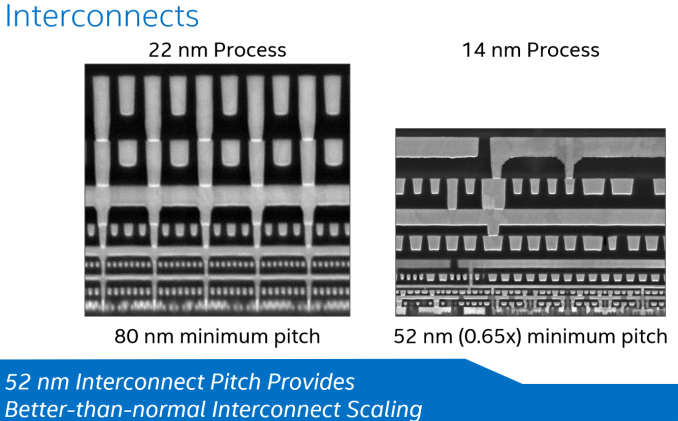ARM Challenging Intel in the Server Market: An Overview
by Johan De Gelas on December 16, 2014 10:00 AM ESTIntel's Future: Xeon-D
Intel's response to all of these competitors is relatively simple. The Atom C2000 might not be strong enough to turn the ARM tide and the Xeon E3 might lose a performance per watt battle here and there due to the extra PCH chip it needs. So take the two and unify the advantages of the Xeon E3 and Atom C2000 in one chip, the Xeon-D. Then use Intel's main industry advantage, the most advanced process technology, in this case the 14nm 2nd generation of trigate transistors.
The Xeon-D should have it all (almost): a Broadwell core that can go as low as 2W per core at 1.2GHz. It can also deliver great single-threaded performance if necessary, as one core can go as high as 2.9GHz! Some people have said that Intel will have a very hard time offering the same richness of integrated hardware blocks as the ARM licensees, but frankly the Xeon-D has almost everything a server application can need: several PCIe 3.0 root complex (24 lanes), 10GbE Ethernet, and PCH logic (6x SATA, USB 3.0/2.0, 8 lanes of PCIe 2.0 and 1GB Ethernet) are all integrated.
Eight of those Broadwell cores will find a place in a 45W SoC. Considering Intel needs 6W to run two cores (and a small integrated GPU) at 1.4GHz, we would not be surprised if the new Xeon-D could reach 1.8GHz or more and that Turbo Boost clocks will be above 3GHz.
The only disadvantage that the SoC has compared to some of the ARM SoCs is the dual-channel memory controller. The Xeon-D will be available in Q3 2015. While roadmaps should always be read with caution, it must be said that Intel rarely delays its products more than a few months. Intel has been executing very well, almost like clock work.











78 Comments
View All Comments
aryonoco - Wednesday, December 17, 2014 - link
I just wanted to thank you Johan De Gelas for this very insightful and interesting article.Hugely enjoyed reading it and your thoughts on the subject.
Good to see high quality content continue to be published at AT now that Anand has left.
JohanAnandtech - Wednesday, December 17, 2014 - link
aryonoco, Jann Thanks for letting me know. A good motivation to always push a bit harder to make sure I don't let my readers down :-).jann5s - Wednesday, December 17, 2014 - link
Thank you Johan, for writing this very interesting article!przemo_li - Wednesday, December 17, 2014 - link
Very well written walk through current and possible CPU/SOC parts.Will there be similar piece for software?
ARM (embedded) folks aren't famous for quality drivers/code.
It must change, so it will change. But for now such overview would be great!
bobbozzo - Wednesday, December 17, 2014 - link
Typo on page2:"(4 Slots x 8 DIMMs)" - change 8 to 8GB
Thanks
bobbozzo - Wednesday, December 17, 2014 - link
and page 4:"you will be able to choose between SoCs that have 100 Gbit Ethernet and 10GBit Ethernet."
should 100 be 40?
bobbozzo - Wednesday, December 17, 2014 - link
Page 12:"Most of them are the usual IPSec, TPC offloading engines"
Should that be TCP?
Also, are there still accelerators for AntiVirus engines and IDS/IPS search (there were some back in 2005).
Thanks
bobbozzo - Wednesday, December 17, 2014 - link
...I guess that's what the RegEx would be useful for.
However, not all IDS/IPS / A/V patterns use RegEx, and there are other means of acceleration.
eanazag - Wednesday, December 17, 2014 - link
Welcome back Johan.Glad to see you're still writing here. Good stuff in the article.
JKflipflop98 - Wednesday, December 17, 2014 - link
I simply don't get where this whole "microserver" thing is coming from.By the time you cluster up enough ARM processors to match the processing power of an Intel/AMD solution, you're burning just as much power and spent just as much money as you would have by using x86 in the first place. Except now you have to use some janky middleware solution because all your software is x86 and you're running on ARM cores.